Put on your stripes and let’s go to prison - but just for the day.
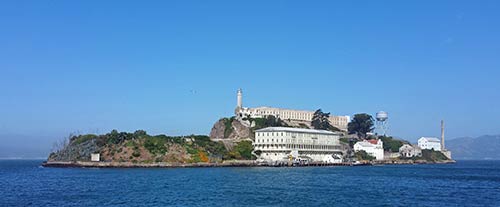
Alcatraz Island looking north from the middle of San Francisco Bay.
Alcatraz is legendary in our lexicon. Much of its lore centers on its infamous, high-profile inmates and much-reported attempted escapes from the almost impossible isolation of this island in the heart of San Francisco Bay, just a mile and a quarter from one of the world’s most beautiful cities. The Birdman of Alcatraz, Al Capone, The Rock, the Native American Occupation - Alcatraz has had countless headlines, numerous books, and many movies - 12 so far - over the decades since it opened as a federal penitentiary in 1934.
| |
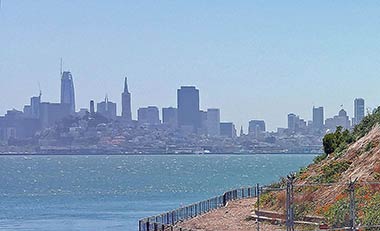 |
|
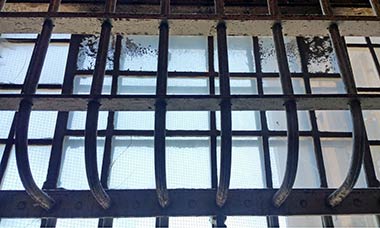 |
|
| |
San Francisco skyline looking south from Alcatraz |
|
Heavy bars on prison cellblock windows |
|
The history of Alcatraz is rich with both characters and stories, not to mention geography. What other federal penitentiary has as its most punishing incarceration feature, that of not just being a prisoner, but being tortured daily by the remarkable view, the visible proximity of one of the world’s most stunning cities; so close - just one-and-a-half miles - yet so far away? http://www.sftravel.com/
| |
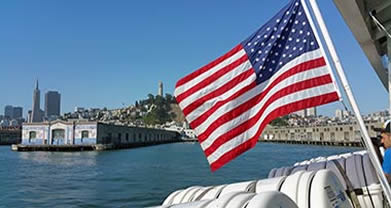 |
|
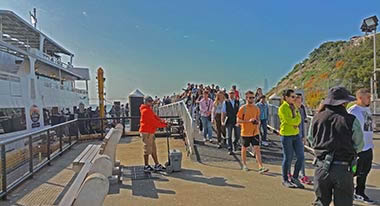 |
|
| |
Pier 33 from the Alcatraz Cruises ferry boat |
|
Tourists arrive at the dock on Alcatraz Island |
|
The ferry to Alcatraz leaves from Pier 33 at Bay Street about every half hour, starting at 8:45 AM. You must have reservations to leave from San Francisco to get to Alcatraz, but your return trip can be whenever you like. The ferry leaves the island every half hour for the mainland until 6:30 PM. Check their website for prices and details. www.alcatrazcruises.com.
| |
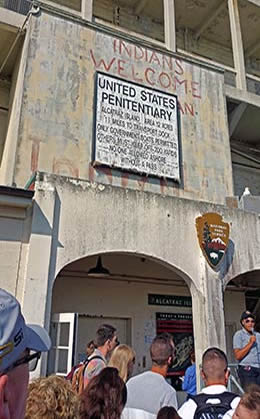
|
|
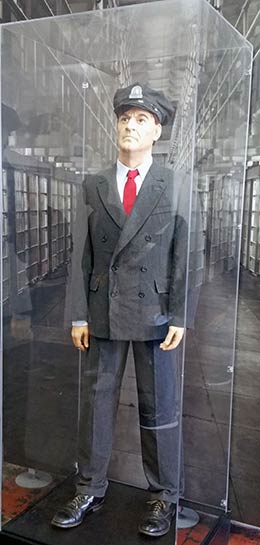 |
|
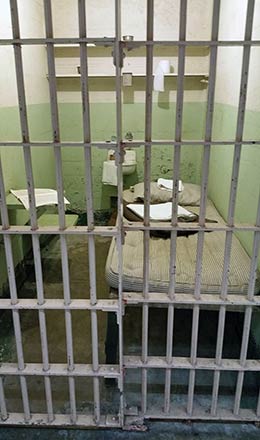
|
|
| |
Park ranger gives talk about the prison and the island |
|
Replica of an Alcatraz correctional officer in front of cellblocks |
|
A typical cell on cellblock B
|
|
The island is a National Park (Golden Gate National Recreation Area, www.nps.gov/goga #FindYourPark) so your first introduction is a short talk by a veteran park ranger who shares some dates and juicy dirt about the island.
* There’s convict time and correctional time. The officers do time, too.
* Inmates got steak dinners. But their real punishment was having to look at that city across the Bay.
* Inmates read more serious literature than the ordinary citizen - especially Kant and Hegel.
* Cells were the size of a pool table - 5’ x 9.’
* Three correctional officers were killed in the line of duty.
* 39 prisoners tried to escape; all but five were recaptured or accounted for.
* Five inmates “escaped” - jumped in the water and never surfaced.
* Ratio of guards to prisoners - one guard to three prisoners. Very high security.
* The Birdman of Alcatraz, Robert Stroud, had no birds at Alcatraz, only at Leavenworth.
* Alcatraz was a military fort during the Civil War and then a military prison (1850-1933).
* American Indian Occupation took place 1969-1971.
* Alcatraz is a Native American word for pelican.
* The prison was closed in 1963 because of expense.
* Every year alumni still gather for a reunion - both former officers and inmates together.
| |
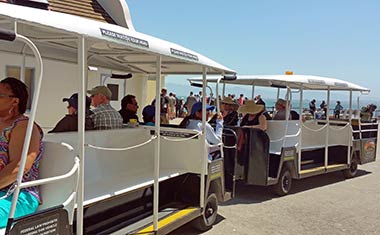 |
|
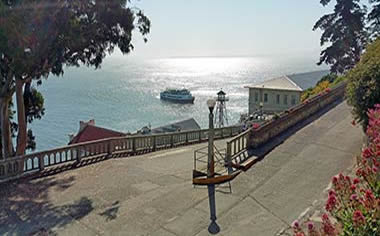 |
|
| |
Electric shuttle from the dock to the Cellhouse |
|
Mid-way up the steep climb to the Cellhouse |
|
The distance from the landing dock to the cell house at the top of the island is about 1/4 mile, about a 13-story climb. For those with mobility issues, there is a tram available at the dock. Those who choose to walk are advised that the hill is steep, the pavement uneven and to wear comfortable walking shoes. It’s also a good idea to carry water. There is no food service on the island, although bottled water is for sale at the dock-level store.
| |
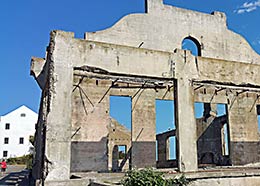 |
|
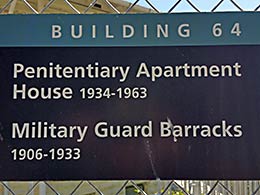 |
|
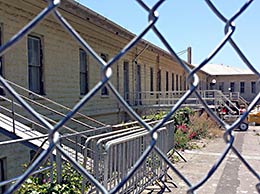 |
|
| |
Skeletal remains of the PX/Officers Club destroyed by fire in 1970 |
|
Sign identifying a building where guards and their families lived |
|
One of the buildings that housed officers and their families |
|
No, the first picture on the left above is not of a Greek ruin. It used to be the Post Exchange/Officer’s Club, the PX, but was destroyed by fire in 1970. Although most corrections officers lived in San Francisco, many, together with their families, lived on the island. This was their social club house and general store. The next two pictures show where they were billeted. There were no female correction officers on the island. The only females allowed were wives and daughters of the officers and warden.
| |
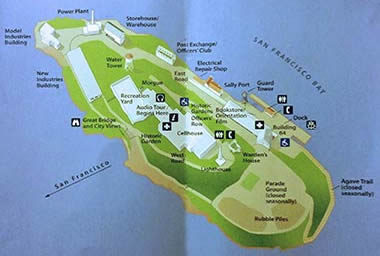 |
|
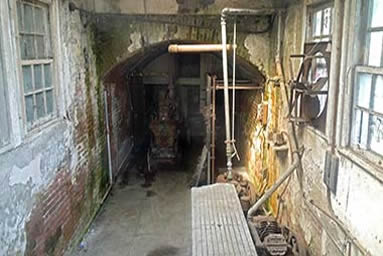 |
|
| |
Overall map of 12-acre Alcatraz Island |
|
Penitentiary morgue on Alcatraz Island |
|
On the climb to the cell house, you will pass this small building which was used as a morgue. The thick, brick-lined walls that once kept gunpowder cool and dry during the Civil War era were also ideal to protect bodies awaiting transport off the island. Notice the exam table in the foreground, and the four vaults on the back wall.There was no “death row” on Alcatraz or any facility for executions. Those who died here when it was a Federal Penitentiary were murdered by other inmates (8), committed suicide (5), or died of natural causes (15). Bodies were sent back to families or buried in local paupers’ graves.
| |
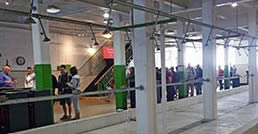 |
|
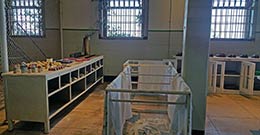 |
|
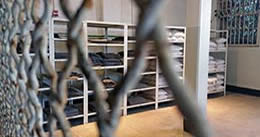 |
|
| |
Tour begins next to showers |
|
Intake room with toiletries |
|
Intake room with clothes |
|
Once you reach the cellhouse at the top of the hill, you’ll pass next to the showers past the inmate take-in rooms where inmates were issued toiletries, clothing and bedding. You’ll be issued an award-winning 45-minute recorded audio tour, narrated by Alcatraz inmates, correctional officers and residents wherein they tell personal tales about life in the cellblocks and on the island. It’s included in your admission price and makes your adventure much richer.
| |
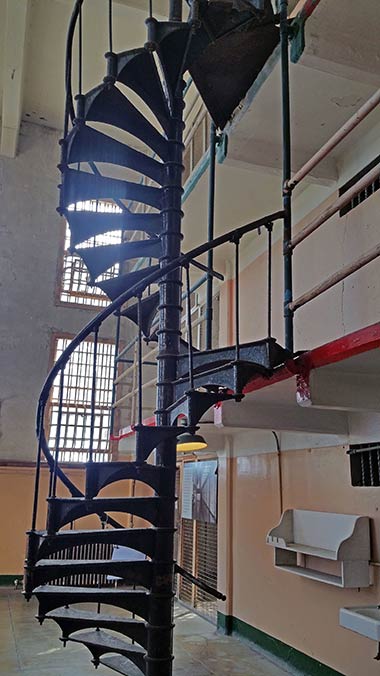 |
|
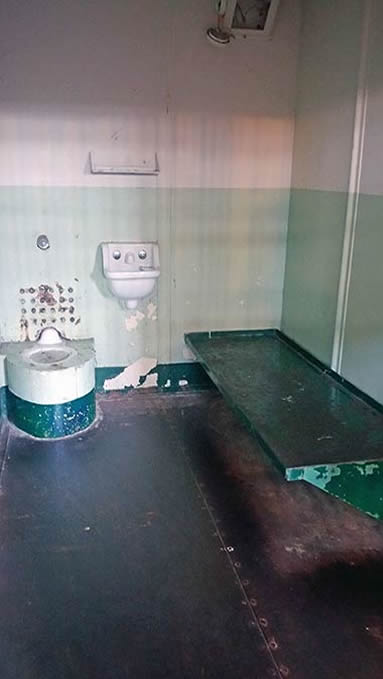 |
|
| |
Staircase between cell blocks |
|
A “nicer” cell occupied by a “famous” inmate |
|
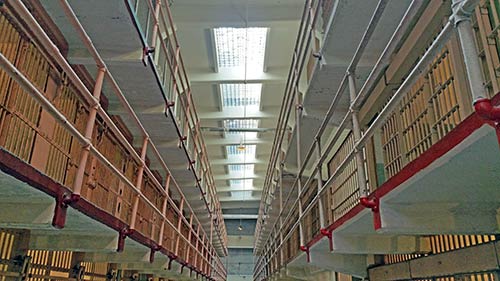
Cell block tiers
Inmates spent time in three of four cellblocks in the prison. Blocks B and C (336 cells) housed the general population and dangerous or violent inmates were segregated in isolation D block (42 cells) - “the Hole,” where The Birdman of Alcatraz, Robert Stroud, spent most of his time. Men received food and health care on D, but were confined 24 hours a day. Al Capone also spent time on D, as did other “famous” inmates.

Seven of the more famous Alcatraz inmates
AZ 85 Alphonse “Scarface” Capone, Income Tax Evasion, transferred from USP Atlanta, on Alcatraz 1934-1939
AZ 117 George “Machine Gun” Kelly, Kidnapping, transferred from USP Leavenworth, on Alcatraz 1934-1951
AZ 268 Arthur “Dot” Barker, Conspiracy to Kidnap, transferred from USP Leavenworth, on Alcatraz 1935-1939
AZ 325 Alvin “Creepy Karpis” Karpavicz, Conspiracy to Kidnap, transferred from USP Leavenworth, on Alcatraz 1936-1962
AZ 594 Robert “The Birdman” Stroud, Murder, transferred from USP Leavenworth, on Alcatraz 1942-1959
AZ 1117 Ellsworth “Bumpy” Johnson, Narcotics, transferred from USP Leavenworth, on Alcatraz 1954-1958 and 1959-1963
AZ 1518 Meyer “Mickey” Cohen, Income Tax Evasion, direct commitment to USP Alcatraz, on Alcatraz 1961-1963
Replicas of the three “dummy head” inmates who escaped at night through the ducts
The 1962 “dummy head” escape from Alcatraz is legendary. Over time, three inmates fashioned dummy heads, put them in their cots, and - in the dead of night - escaped down tunnels and ducts. See the holes under the sinks where their escape routes were accessed. These three were never accounted for. Their escape was immortalized in the movie “Escape From Alcatraz” with Clint Eastwood.
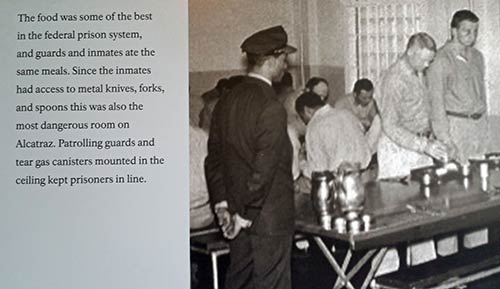
Historical photo of the guarded dining hall
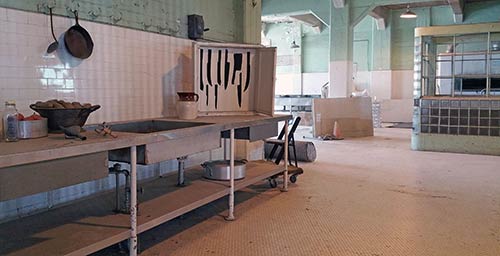
Knives were kept in a locked cabinet in the large kitchen
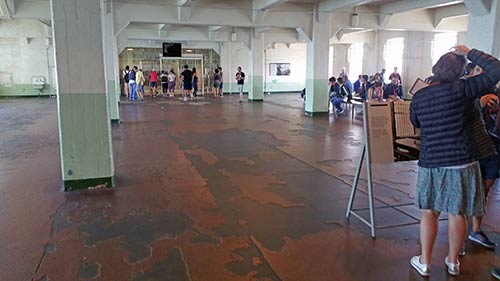
The cavernous dining hall as it looks today
The food was some of the best in the federal prison system. Guards and inmates ate the same meals. Since the inmates had access to metal knives, forks, and spoons, the dining hall was also the most dangerous room on Alcatraz. Patrolling guards and tear gas canisters mounted in the ceiling kept prisoners in line, but the tear gas was never used.
| |
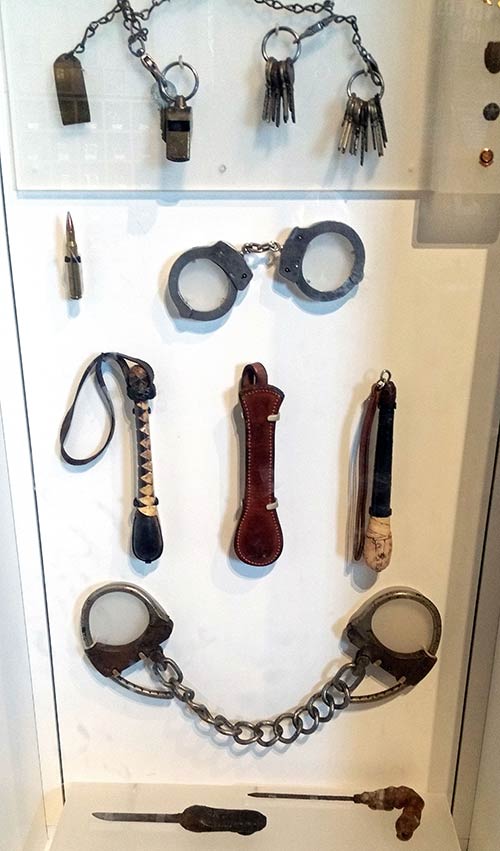 |
|
On the Cellhouse floor, officers worked without badges, pens, or anything else that could be used as weapons against them. Contrary to regulations, some secretly armed themselves with “saps” - short, leather-wrapped metal clubs. Inmates fashioned “shivs” - weapons made from anything sharp. |
|
| |
Some of the prison weapons used by both inmates and guards |
|
|
|
Remnants and memorabilia from the 19-month Native American occupation which began in 1969
After the prison closed in 1963, casino resort developers tried to buy it. Native Americans staged an occupation in November, 1969, claiming treaty rights to the island and stayed for 19 months. Echoing the 1626 purchase of Manhattan Island, they offered to buy the island from the Federal Government for $24 in beads, colored cloth and other trade goods. Nixon finally established a new policy favoring the protesters’ demands and commercial development plans never materialized. Alcatraz became a national recreation area in 1972 and received designation as a National Historic Landmark in 1986.
Some of the most popular souvenirs available for visitors in the gift shop at dockside
Prison memorabilia, books, maps and lots of lore is available in the dockside gift shop, Many of the rules and regs from the prison Cellhouse Rules and Regulations booklet given to all prisoners are popular take-aways for visitors.
| |
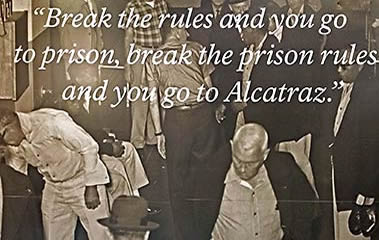 |
|
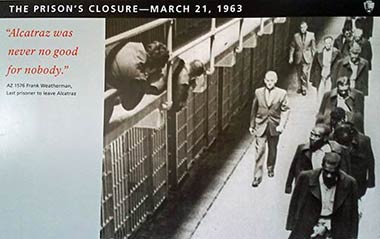 |
|
| |
Inmates first day at Alcatraz |
|
1963 photo of the last inmate to leave Alcatraz |
|
The last inmate to leave Alcatraz at the prison’s closure on March 21, 1963, was AZ 1576 Frank Weatherman. His final comment to the press on that occasion: “Alcatraz was never no good for nobody.”
You can pay a virtual visit to Alcatraz at http://www.nps.gov/alcatraz.
Lynn Rosen is an Emmy-winning broadcast and print journalist, a member of the Society of American Travel Writers (SATW), the North American Snowsports Journalists Association (NASJA), and the American Theatre Critics Association. Her global travels continue to take her on challenging adventures that she ultimately shares with the many visitors to this website.
|